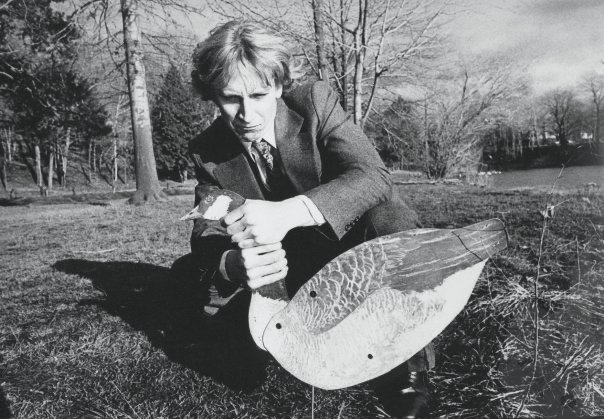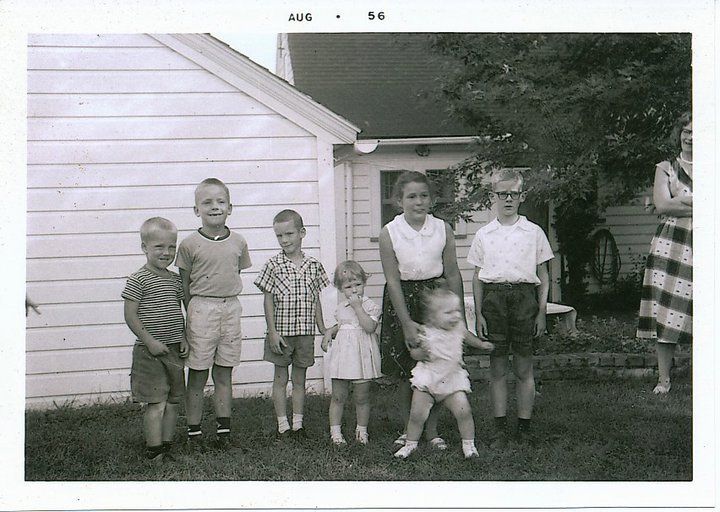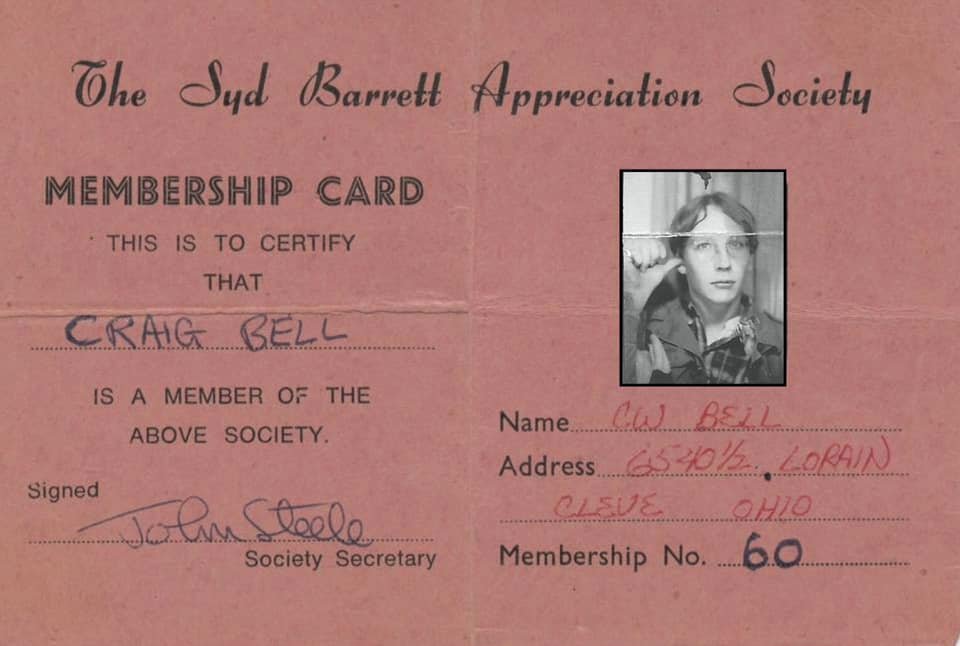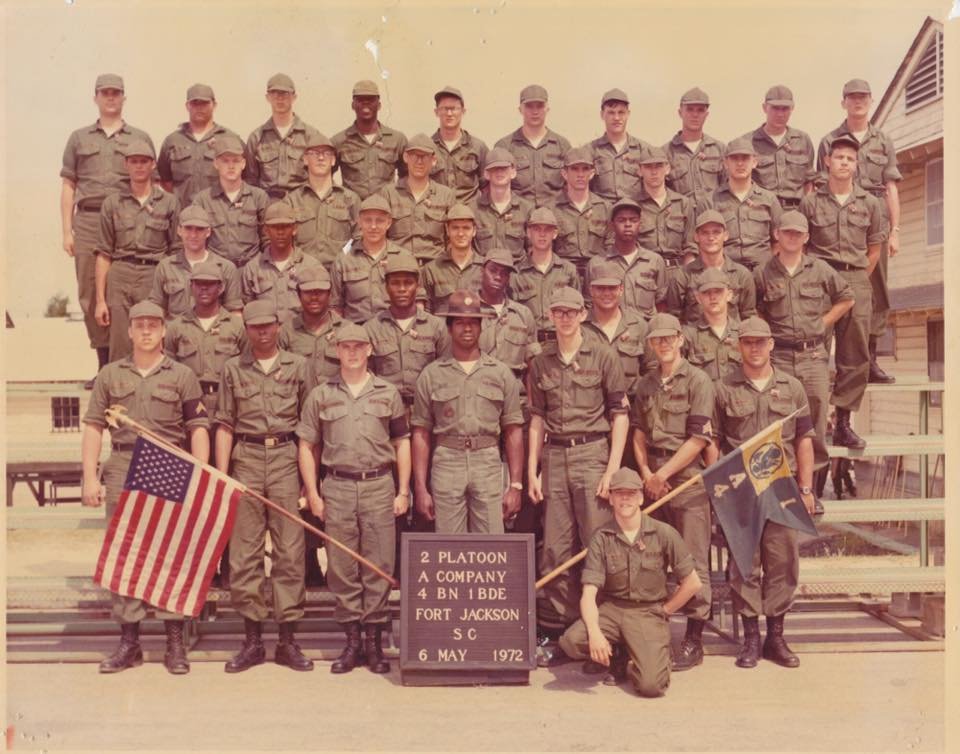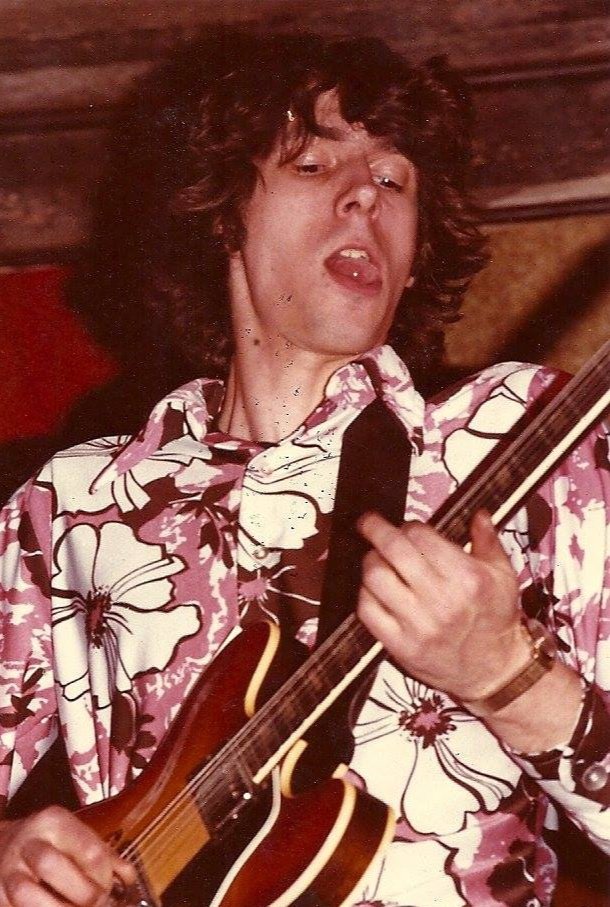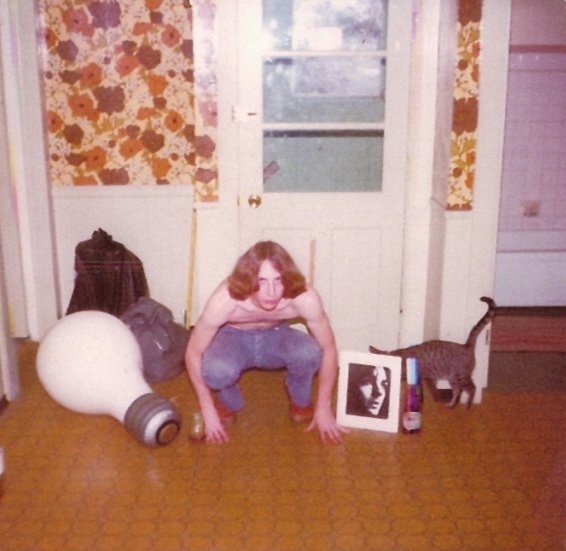Craig Bell - Mirrors and Saucers Interviews
Tell me about growing up in Lakewood, Ohio? What was your childhood like? When did you first begin to fall in love with music and what was it that initially fascinated you about it? Was this something that was relevant around your household growing up? Do you have any siblings?
I moved to Lakewood with my family from New Jersey in February of 1961, couple of weeks before my ninth birthday. I was the second child. My older brother and I were born in Elmira, NY. A sister came along a few years after while we lived in Buffalo, NY, and another sister during our brief stay in Denville, New Jersey. My father worked for the railroad and as he advanced we moved to his new work location. Upon our arrival in Ohio, he had been promoted to the head office in Cleveland. I was introduced to music as a young age via the radio. I remember spending Memorial Day listening to the Indy 500 while our neighborhood in Buffalo celebrated with a pool party. I was 5 years old. Sam Hanks won the race. Most of my early listening years were spent trying to find how many different radio stations I could discover with the antenna my brother and I strung in the attic of our house in Lakewood. We also had a shortwave radio and listened to worldwide broadcasts. I was exposed to all sorts of music, talk, news, and sports. I kept a log of stations I could hear well enough to decipher their call letters and determine their location. I was really excited one night to discover I was listening to a broadcast from Denver, Colorado. In the spring of 1968, I fell asleep listening to a Cleveland Indians baseball game from the west coast and when I heard the announcer talk about a Kennedy being shot, I thought I was dreaming about JFK. As I awoke in the early morning I realized it was no dream. RFK had been assassinated in Los Angeles. The radio certainly introduced me to the new music exploding in the 1960’s and the biggest influence on me, and many others in the Great Lakes region, was CKLW in Windsor, Canada. They played the latest British invasion bands as well as the newest Motown hits out of nearby Detroit as well as whatever else was new and happening in the region and country.
What would you and your friends do growing up? When and where did you see your first concert and what kind of impact did that leave on you?
When not glued to the radio, I grew up with a group of friends in my neighborhood playing the usual games of baseball, football and other sports. I played organized hockey for a while but mainly wanted to play rock music! When not listening to the latest hits on the radio, I was starting to buy records. First only singles, but soon enough the occasional LP. My first 45 purchase was Itsy Bitsy Teeny Weenie Yellow Polka Dot Bikini when I was 8. My first LP was Vanilla Fudge at 15. As my knowledge grew, so did my taste. I had a ways to go. The first live music I saw was at school or church functions that would have a teen dance band. I loved listening to music but something really clicked when I saw people actually playing on stage. I felt the urge to be one of them. I had a tough road ahead. My parents, mostly my dad, did not care for the new music and barely tolerated my brother’s and my playing our Beatles, Stones, Kinks, records on our little GE portable player in our shared bedroom. There was no way we were allowed to play them on the console stereo down in the living room. That was reserved for my parents Sinatra and Jackie Gleason Orchestra records, as well as my dad’s beloved bagpipe albums.
(Teen-age rebel me secretly loved them too) Another no-go was a guitar. We were told that if we were interested in playing music then it had to be a proper instrument. The public schools offered instruments for the students and we would have to pick from that. I first tried the trombone. I sucked at it. Next came the clarinet, same result. Since I couldn’t bring home a guitar I did the next best thing, hanging around with kids that could. One of those guitar players was Michael Weldon. Michael played guitar in a band called The Rivers Edge and I became friends with him when we met in high school. Michael introduced me to a vast array of music, and along with Jim Jones, was directly responsible for turning me onto so many great groups that I can’t recall ones that I discovered on my own. Michael also became the drummer in Mirrors later on. I did not get to see too many touring groups until my junior and senior years of high school. Once I did start going to concerts I certainly was in the right place because everyone who was anyone played in Cleveland in the late 60s and early 70s, especially if they were from England!
Who were some of your earliest influences? Did you participate in any groups prior to Mirrors?
One Summer Saturday afternoon, and friend and I sat through the British movie Ferry Cross The Mersey, starring Gerry & The Pacemakers. On the walk home we both decided we wanted to be in a band. It was 1965. I had already seen A Hard Days Night the year before as well as The Beatles appearances on TV, thanks to my mom. My dad didn’t want to watch Ed Sullivan’s show the night of The Fab Four’s debut and only relented when she said she did. I don’t know if she did that for my brother and I, or for herself, but I thank her every day for it! Now, knowing what restrictions I was under, I had to find a way to do that. I had discovered many exciting bands through my friends and the new music magazines that started appearing on the racks at the local drug store. Earlier I had read about the artist Andy Warhol in one of the weekly magazines that covered what was new and interesting in the early 60s and they mentioned he was mentoring a band called The Velvet Underground along with his other pieces of Pop Art. Soon after, a friend bought the first Velvets album and after a listen, I bought it too! I liked a lot of the bands of the late 60s that came out of the West Coast as well as latter English groups like Mott The Hoople and Hawkwind. I went to a few music festivals and saw a lot of my favorites in that time. I would hang around guitar player friends and try to pick stuff up from them if they had a spare laying around for me to play with. One of those players was an older guy who went to a different school but dated a girl from Lakewood High. His name was Jim Crook.
How did you initially meet your bandmates as well as the band forming in ‘72? What were those early jam sessions and rehearsals like when you guys first got together?
I met Jim in 1969 and a few months after that he was drafted and shipped of to Viet Nam. Two years later, In the Spring of 1971 I ran into Jim at the Agora in Cleveland where we both were to see the smoldering remains of what once was the Velvet Undergound led by Doug Yule. I was now out of school and living on my own. I had just returned from a few months in California in Stockton and San Francisco. Jim mentioned he and Shari, now married, were living near where I was staying and invited me over to spin records and meet his friend Jamie Klimek. I brought along my Syd Barrett album that Jim was interested in hearing. We all had a good time playing records and in other visits Jim and Jamie played me tapes they had recorded of songs the two of them had written and recorded on a nice Teac deck that Jim had bought overseas. I was impressed and told them my desire to be in a band. Jamie mentioned they needed a bass player and a drummer. I told them I’d like to learn the bass and I might know a drummer. Jamie handed me a bass he had, a Hagstrom 8 string (without the harmonic strings) and showed me how to tune it. He then told me to figure the rest out for myself. Shortly afterwards we started rehearsing together.
I took small bits of masking tape and put them under the strings at each fret of the bass and wrote what note was at each position. From there, playing along to records, and being tutored by Jamie and Jim I learned to play. Soon Jamie and I moved in together in a first floor garden apartment in Lakewood and started rehearsing there. We still needed a drummer so I asked Mike Weldon if he was interested in playing drums and he said yes even though he was not a drummer. We got a set of drums donated to us by a friend of Shari’s and we were Mirrors! We rehearsed at the Clifton Blvd apartment through the year. In early 1972 I got my draft notice and told to report for duty in April. After basic training, I was sent to signal corps school in NJ for nearly a year. On a number of weekends I would come back to Lakewood and we would rehearse. The rest of the time Jim Jones took my place in the band and Paul Marotta also joined during this period. Upon my return to Cleveland in early 1974, Jim Jones stepped aside and I returned to being Mirrors bassist. Jim was a great musician and a great friend. I miss him. Cleveland misses him.
When and where did the band make their live performance debut and what was that experience like?
Before I left for the service we played a gig at the Lakewood YMCA and a private party shortly afterwards for a bowling team. While I was away Mirrors also did a show at St. Joseph High School. Once I was back home we found a new living situation/rehearsal space above an vacant store front on Lorain Avenue on the west side of Cleveland. Jamie, Michael and I lived there and we would rehearse frequently. We started playing clubs down by Cleveland State University like The Viking Saloon and Clockwork Orange. We also played out in Berea a couple times at the college and the fair grounds. I remember both those jobs well because at the college show we were joined by an older gentleman who did a fantastic light show and the stage at the fairgrounds was so high I wouldn’t go near the edge. I was also nearly electrocuted by badly grounded mic.
Tell me about writing and recording in those early days, as there were no records, or music released when the band was around in their heyday. What was the overall vision for the music as well as what you guys wanted to achieve and express?
Jim Crook recorded a few early rehearsals on his Teac, but mostly we would use a simple desktop cassette recorder while we rehearsed. The first time we went to a studio to record was in the Summer of 1974. Michael’s friend, and another Lakewood High alum, Brian Reisner, recorded a set of our songs. Some of those tracks were released much later. We didn’t have the resources to get a release together at the time. What has surfaced over the years is a good representation of the band. We were really influenced by the Velvets, and The Troggs, Stooges, and early Pink Floyd. We took all that and gave it a little twist. Jamie Klimek wrote a lot of wonderful songs and they were a blast to play. I am very proud what the six of us created.
Why were there no albums released when you guys were still together? What eventually happened to the band after ‘73?
The simple answer is, we didn’t have any money and we didn’t know where to get any. Paul had released an EP before he joined the band but our lack of cash kept us from our DIY dreams. In the Fall of 1974, Mirrors were on a hiatus of sorts when I was asked by Peter Laughner to join a new project he was putting together with David Thomas. They had a group called Rocket From The Tombs and were re configuring its lineup and direction. I started rehearsing with them and two younger guys, Gene O’Connor and John Madansky, at their loft in downtown Cleveland. Their plan was to record some songs to be played on the local FM station WMMS. Peter had convinced the program director to broadcast a tape if we could make one. Shortly after Christmas that year a show was put together to debut the new lineup of Rocket From The Tombs, along with Mirrors and electric eels at the Viking Saloon. Jamie asked me to play the Mirrors set but not play with RFTT. I had told him when I went to work with Peter and the band that I would put Mirrors first, so I sat out RFTT’s debut set that night. Not long after that I was sent a letter from Jamie relieving me of my duties in Mirrors. I was upset about it but by then RFTT had been gaining recognition around town and I was putting more of my attention to that band so I was not surprised I was out. I will always be grateful to Jamie and Jim for giving me the opportunity to learn and grow as a player and a writer. I couldn’t have had better mentors. It wasn’t until a couple of years later that the Shirley single was released on Hearthen. Rocket From The Tombs had flamed out by then and I had moved to Connecticut.
What was next after the Mirrors? I understand you played in many different projects including Future Plan, Deezen, The Bell System, Rocket From The Tombs and countless others.
Rocket From The Tombs short life had ended by the end of 1975. I was offered a position in both the immediate offshoots, David & Peter’s next outfit, Pere Ubu, as well as Frankenstein, later renamed The Dead Boys. I rehearsed a bit with Gene and John, now Cheetah Chrome and Johnny Blitz, along with Stiv Bators and Jimmy Zero as well as working with Kevin McMahon for a while in what was to become Lucky Pierre, but I was restless. I had started writing some songs while in Mirrors and continued writing with RFTT. Pere Ubu’s second DIY single was a reworked version of RFTT’s Final Solution for which I received my first published writing credit. I wanted to take the next step and form a band around my songs. I also was tired of having no money and lousy jobs. In the spring of 1976 my father helped me find a railroad job with Amtrak and I moved to New Haven, Connecticut, along with my girlfriend Rene, to begin working there. I had worked summers in Cleveland after high school on the railroad as a trackman but with my electronics training I had in the Army, I was qualified to be hired as a signalman. It took us about a year to get our bearings in our new location but once we did, I began looking for people to start making music with. I started visiting local record shops and met some like minded people there. I also would peruse the musicians wanted ads in the weekly arts paper. I went to a few auditions but nothing was working out. One of the auditions I went to in New Haven was for a local singer who was putting a new band together for a record deal. I wasn’t what they were looking for but I can say I tried out for what became The Michael Boloton Band. I hear he has done well since then after changing his last name to Bolton. I answered an ad seeking a bass player for a recording project in nearby Bridgeport. I met with them and we rehearsed a few times in the basement of the singers house where we hit it off and they took me on for the recording.
They only had one song they wanted to record so I suggested they try one of mine. I showed them Muckraker, which I had written while in Mirrors, and also brought to RFTT. They liked it and we worked up a version for the session. Soon after we finished the recording was done Terry Smith the guitarist, invited me to a show his other band was playing at The Snake Pit, located in the Hotel St. George in Bridgeport. The show was fantastic and even a raging snowstorm could deter us form getting there to see Raw Power, Terry’s band. Their recording didn’t become a single and in 2014 the version of Muckraker we did that day finally was released on my album “aka Darwin Layne” in 2014. I put my own ad in the paper soon after and in short order, Malcolm Doak, Malcolm Marsden, Mark Mulcahy, and I started rehearsing together as Saucers. We practiced nearly daily for a couple of months at a loft we rented by the arena in downtown New Haven. When there were big shows at the arena, Mark made a few extra bucks parking cars in the small lot behind our building. That worked out great for him until our landlord found out about it. After that, the landlord had his son running that operation. We would have the windows open on the hot summer days and sometimes when we stopped playing we would hear applause and cheers outside on the street three floors below. On occasion some of them would come upstairs and knock on our door. I met folks who became very close friends from those days. One was Tom Hearn. He and his friend, Legs MacNeil of Punk Magazine fame, came up after hearing us on the street and soon he offered us our first gig in November of 1978 at a bar in a strip mall in Devon, CT.
Soon after that, we went into Trod Nossell Studio to make our first recordings. We recorded six songs with Richard Robinson engineering and teaching us how to record our songs properly. We had plans to release a single from these recordings as we were starting to play on a more regular basis around town and along the shoreline. Before we amassed enough cash to do that, keyboardist Malcolm Doak left the band and we welcomed Seth Tiven as a second guitarist. Soon after that we continued playing around Connecticut and began to travel to New York City and Boston to play at CBGB, Max’s Kansas City and The Rat. We returned to Trod Nossell and Richard to record another set of songs in the spring of 1979. From that session came our first single released later that year. Malcolm Marsden wrote the a side, What We Do, while two songs of mine were on the flip, Muckraker and I Didn’t Get It. We continued playing shows into 1980 and that summer Malcolm left the band and keyboardist/guitarist Katherine Cormack joined us in time to record our second single, A Certain Kind of Shy/She’s Alright. We went to Audio West with Joe Mendyk engineering to record a set of songs later in the year which became our last recordings before the band split up at the end of the year. Marl Mulcahy went on to start Miracle Legion and Seth Tiven moved to Boston to form Dumptruck. Saucers complete studio recordings were released on CD by Grand Theft Audio Records in 2002. I started a label with my friend and producer Bill Murphy and his partner Phil Weinberg. Gustav Records released the Saucers 45, along with singles by Bill’s band, The Bats (featuring a young Jon Brion), and The Poodle Boys as our inaugural efforts. The label has continued in fits and starts since then releasing albums, singles, EPs, and later, CDs, of Connecticut artists and starting in 2002, releases by bands here in Indiana. Gustav’s latest release is my first solo album, “The Room In My Head”, in 2020.
Our motto: “Gustav Records 43 years, and still in the red!”
I joined up with Forrest Harlow, Michael Barone and Jon March to start Future Plan in 1981. We briefly were called Plan 9 until we were notified that there was a band out of Rhode Island who had the same name and a record out. So Future Plan it became. We continued to play all over New England and down to NY. Jon left the band but not before we recorded some songs at a blisteringly hot studio in a barn in Milford, CT in July of 1982. At the time we also had a sax player with us named Mark Brown. After a weeks long search for a bassist, and a short stint with a guy named Mike, we welcomed Claudia Chapman to the band and changed our name to The Plan. Soon after we returned to Audio West and Joe Mendyk where we recorded four songs. Two of Forrest’s songs became our single, I Love NY I Hate NY/When It’s Too Much, on Gustav in 1983. Another personnel shuffle came in 1984 along with a new name. Tom O’Connell joined us as Forrest departed and The Plan became The Bell System. TBS recorded some songs at our loft in the Johnson Building in New Haven engineered by our soundman Kevin MacDowall while we continued our touring schedule through the next couple of years. My song, America Now, appeared on a radio only sampler in 1985 and was the only recorded output from this band up to its demise in 1986. By this time Claudia and I had married. The Rhythm Methodists was our next band, Claudia, Kerry Miller and I recorded a number of songs of ours and a few select covers at Ron Sutfin’s studio in Wallingford, CT as well as at a recording school in Bridgeport. We did not do any live shows with this band at that time. I had met Kerry in 1977 when he and Ricky Rondo knocked on Saucers’ rehearsal room door. Kerry and Rick became mainstays of the Connecticut music scene with their band Hot Bodies, and many more. Some fans of the TV series Chopped may know Ricky Rondo as Chef Ric, he and his wife ran a very successful and loved restaurant in Saugerties NY for decades.
Recordings from The Bell System, Future Plan, The Plan, and Rhythm Methodists came out on the aforementioned “aka Darwin Layne” on ever/never records. The album also contains my first song, Slow Down, performed by Mirrors in 1974. By 1989 we needed a change of scenery. I was frustrated in my musical efforts and had put myself in a bad physical and mental state. I knew I had to do something soon or I was going to have some serious problems. I sought a transfer in my job and after a false start that would have landed me in Chicago, Claudia and I moved to Indianapolis, Indiana in the fall of 1989. I continued to work on the railroad and Claudia used he journalist and computer skills to secure a job in book publishing. We bought a house and I put the guitars under the bed for a couple of years as I tried to figure myself out and quell some of my demons. In retrospect, I wish I hadn’t done that but if I had continued on the way I was going, I don’t think I would have survived. In 1995 I reconnected with an old guitarist friend from Connecticut who was now living in Columbus, Ohio. Joe Guidone was in a band from Hartford called The Not Quite and we had shared the bill at a lot of clubs back in the 80s. Claude and I started to go to Columbus on weekends and jam with Joe and some of his friends. We ended up starting a band called Shepard’s Pie and would play a Christmas benefit called Trash Fest at a l’il Brothers for a few years. We also opened for the great Thomas Jefferson Slave Apartments, Ron House’s 90s band. We mostly did covers. I had stopped writing songs. I didn’t have anything to say. I had visited Cleveland infrequently during the 13 years I spent in the East, I returned on NYE 1981 and saw Lucky Pierre perform at The Fantasy in Lakewood. Claudia and I visited once and we hung out with Jim Jones. After we moved to Indiana our visits to Cleveland became more frequent. One visit I found myself sitting in Jim Jones’ kitchen with David Thomas as they played for me a tape of RFTT’s set opening for Television in 1975. I knew that Jones had taped Television that night because I was sitting next to him while he did it. It never occurred to me that he also recorded us that night. David said he would like to do something with the tape someday. I told him I hoped he did. Claudia and I visited David at his home in Brighton, UK in 1999 and we talked about the tape again. I was getting the itch to play again and I was hoping something would happen to get me back in the game.
In 1996, after attending a party at The Pop Shop in Cleveland for CLE Magazine, Jim Jones recommended me to the Rock and Roll Hall Of Fame and Museum as a panelist on a series they were doing about Cleveland music history. In April 9, 1997, onstage in the Rock Hall’s auditorium, Jimmy Zero and I were interviewed by one of the curators about the 70s “Punk” scene in Cleveland. We also performed a few songs from our respective bands, Dead Boys and Mirrors/RFTT, plus, with Claudia on bass, my song America Now. We were billed as The Atomic Bombs and were backed by Cleveland musicians Barb Eckles, Dave Cintron, and Frank Vazzano. We were told later that we were the first full electric band to perform on the RnRHoF&M stage! In 2001, Jim Tennyson wrote me from Cleveland and introduced me to Brian at GTA Records in Los Angeles. Brian wanted to put out a compilation of all the Saucers studio recordings. I still had the mother tapes and took them to a studio in Indianapolis where I met a young engineer named Tyler Watkins who helped me get the tapes digitized and remixed for the 2002 album “What We Did”. This CD and the 2016 LP “Third Saucer From The Sun” released on Rerun Records in St. Louis got Saucers out to the world. In 2002, David Thomas and Smog Veil Records announced the release of “The Day The Earth Met Rocket From The Tombs”, the first official release of the archival recordings of the band from 1975. There had been a couple bootlegs circulating in the 1990s of some of the recordings we had made at our loft for WMMS as well as a few live tracks from our shows at the Cleveland Agora but none of the set from The Piccadilly opening set for Television had been heard up until then.
TDTEMRFTT was a good seller and by the end of summer David asked if I would be interested in doing a one off performance of RFTT at his Disastrodome festival in Los Angeles the following February. David, Cheetah and I convened in Cleveland to start figuring out how this was going to happen. We discussed who could play guitar along with Cheetah and it was decided to ask Richard Lloyd to participate, and he readily agreed to do it! Steve Mehlman, the drummer with Pere Ubu at the time, joined us. We did the show to a sold out crowd on the UCLA campus. I remember just before we were to go on a couple of guys come up to us breathlessly asking if we had gone on yet. They were relieved to know we hadn’t because they had just rushed from LAX after flying from New Zealand to see us! This one off show turned into a two week tour in June 2003 where we returned to Cleveland as well as Columbus, Pittsburgh, Philadelphia, a live performance on WFMU in Jersey City, and two nights in NYC. It was decided to do a national tour in the fall. Richard offered his rehearsal/recording studio in Manhattan to record a tour album of the present lineup of the band and the result was Rocket Redux on Smog Veil in 2003. We did a 28 date tour starting in San Deigo and crossed the US and Canada. The following years found us playing more shows in the US, Canada, and then traveling to Europe. We made two more albums, “Barfly” in 2011 for Smog Veil, and with new guitarists Buddy Akita and Gary Siperko replacing Cheetah and Richard, produced Black Record for Fire Records in 2015. By 2008 I felt back on my feet and decided I wanted to put together my own band again. I started the Down-fi in Indianapolis with Samuel Murphy, Mike Theodore, and Jason Bambury. Jason and Mike left the band after the recording of the “America Now” CD which was released on Gustav Records in 2009. Blane Slaven joined on drums and I switched back to bass for our next EP “Beehunter” 2011. We recorded a couple of singles and added keyboardist Mark Wyatt from Great Plains and Phil Kitchel replaced Blane on later recordings. During this time Sam and I also formed a band with Dan O’Connell (no relation to TBS guitarist Tom O’Connell), Kelsey Simpson, and Mike Rippy called Deezen. Both bands played around the Midwest for a number of years. The Down-fi also traveled to the East Coast, New Orleans and Texas for shows.
Around this time, my old friend Kerry Miller moved to Indianapolis after marriage to a woman he met on tour here with his CT band Peacock Flounders. Soon Kerry replaced the departed Dan on vocals for Deezen and we opened a few shows for the reformed original Gizmos. As a result of that The Gizmos asked Sam, Kelsey, and I to be their backing band on a recording and a few shows in Ohio. We made the “21st Century Gizmos Fans Can’t Be Wrong” EP for Gulcher Records in 2015. In August of 2014, I was contacted by John Morton legendary electric eels founder and guitarist. After the eels demise in 1975 John formed a short lived band called X blank X who released a couple of singles on Drome Records in Cleveland before he left there for NYC in 1980. He was reforming the band to tour behind an archival album that was released on a label in Finland in 2014 “XStickyFingersX” in 2014. He needed a bassist as the original player, Jim Ellis of CLE Magazine fame, declined. I accepted and we, along with original member Andrew Klimek (Jamie Klimek’s younger brother), and a number of drummers filling in for original member Anton Fier including Matthew Harris, Lamont Thomas, Weasel Walter, Osvaldo Rodriguez, and Andy Jody have toured across the USA over the past decade as well as releasing “XThe Jazz DestroyersX present Albert Ayler’s Ghosts Live at the Yellow Ghetto” in 2015 on Smog Veil. We have recorded a third album “XThe Monster That Ate ClevelandX” (recorded in 2018 that awaits release). I started touring as Craig Bell and Band after the release of “aka Darwin Layne” and recorded my first solo album with touring band members Brad Wallace and Dusty Privette along with many friends from other bands I have worked with and local Indianapolis musicians I have met recording with Tyler Watkins who has helped me with all my recordings since we met over 20 years ago. Presently I am recording and touring with The Dead Man’s Handle which comprises Greg Moran, Phil Reavis, Will Sibley and myself.
What keeps you most interested in writing and recording music after all these years? Is there anything else you would like to further share with the readers
In February of 2012 I was in a dressing room staring at myself in the mirror. We were about to do our set in San Antonio, Texas. It had been nearly 10 years since Rocket From The Tombs reformation had started me back on the road to playing, writing, and recording. Something I hadn’t ever expected to be doing again during my darkest hours 20 years before. I remember looking into my eyes and saying, “This is what you wanted”. I smiled at myself and went out onstage. I’m grateful to many people who have helped me over the years achieve the dreams I shared with my friend Dave many, many years before on a walk home from the movies. The only piece of advice I can give anyone who has a dream is, it’s ok to take a break if you need it. Just don’t ever say “never”. Because you just never know.


